Introduction
Credits: 4
Contact Hours: Two 110-minute sessions per week for the on-campus lecture and no contact hours for the online section.
Prerequisites: No courses are required before taking this one.
Catalog Description: The varieties of computer hardware and software. The effects, positive and negative, of computers on human lives. Ethical implications of information technology. Hands-on experience with a variety of computer applications. Lec/lab.
Categorization: Required for some programs.
Recent Instructor(s): Joseph Jess, Pam Van Londen
Communication Policy
Contact Joseph Jess, Instructor, via Canvas Inbox.
Group Help sessions are posted in Canvas.
Adhere to these other ways to get help:
Open-ended questions
about the course, assignments, etc. can be answered in Ed Discussion for the group's benefit.Personal questions
should be asked via Canvas Inbox.Scoring questions
should be asked via the Canvas > Grades > Assignment > Comment Box.
Course Learning Outcomes (CLOs) and NACE Competencies
Upon completion of this course, students will be able to:
- Create projects using a variety of computer software applications.
- Understand the positive and negative effects of computers on human lives.
- Understand the ethical implications of information technologies.
Read more about OSU's Learning Goals
The career readiness of college graduates is an important issue in higher education, in the labor market, and in the public arena. Through a task force of college career services and HR/staffing professionals, the National Association of Colleges and Employers (NACE) has identified eight Career Competencies: career and self-development; communication; critical thinking; equity and inclusion; leadership; professionalism; teamwork; and technology. The topics and assignments in this course are meant to prepare you to meet those competencies. See how they tie into the student learning outcomes and objectives/deliverables.
You can learn more about these competencies and how to include them in your résumeé using the OSU Career Guide provided by the OSU Career Development Center. Or, include them each week as you complete assignments (to earn extra credit).
| NACE Competency | Learning Outcomes | Objectives (Deliverables) |
|---|---|---|
Communication
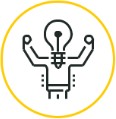
|
Understand the positive and negative effects of computers on human lives.
Understand the ethical implications of information technologies. |
|
Critical Thinking & Problem Solving

|
Understand the positive and negative effects of computers on human lives.
Understand the ethical implications of information technologies. |
|
Teamwork & Collaboration

|
Understand the positive and negative effects of computers on human lives.
Understand the ethical implications of information technologies. |
|
Leadership

|
Understand the positive and negative effects of computers on human lives.
Understand the ethical implications of information technologies. |
|
Professionalism & Productivity
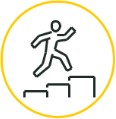
|
Understand the positive and negative effects of computers on human lives.
Understand the ethical implications of information technologies. |
|
Career & Self Development
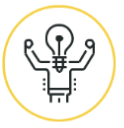
|
Understand the positive and negative effects of computers on human lives.
Understand the ethical implications of information technologies. |
|
Equity & Inclusion

|
Understand the positive and negative effects of computers on human lives.
Understand the ethical implications of information technologies. |
|
Information Technology Application

|
Create projects using a variety of computer software applications. |
|
Course Schedule of Chapters
OSU's definitions and guidelines for quarter credits 120 hours of your time will be needed to read and understand the readings, participate in skill-building activities, and complete assignments for this 4-credit course (that's 12 hours per week). The 8-week Summer Session will require more time per week because three (rather than two) assignments are due each week.
| Week | Objectives | Points |
| 0 or 1 |
Syllabus Quiz
Check your understanding of the communication policy,
outcomes, schedule, late policy, learning resources,
writing requirements, software requirements, cyberbullying types,
emotional and cultural intelligence,
and services.
Canvas Quiz Check your understanding about using the Discussion board editing and image options, Inbox, Assignment Comments, Viewing Due and Available Until dates, etc. |
20 points |
| 1 |
Tools and Introductions
Learn Skills: Connect to VPN. Make a course folder in Documents. Update your operating system settings. Login to OSU cloud drives. Take a cropped screenshot. Insert the screenshot into a word processing document. Use keystrokes and employ ergonomics. Test your system's speech, audio, and video apps. Verify your work. Submit the file and sharing URL. Discuss Introductions: Introduce yourself. Discuss cognitive styles and software experience. Participate in the Discussion. Verify your work. |
33 points |
| 2 |
Modern Learning
Learn Skills: Improve note-taking with note-taking applications. Choose a bibliography tool. Synthesize modern learning. Summarize job skills. Update your Gmail email settings. Create a formal message. Review the TurnItIn Originality Report. Ask for help. Verify your work. Submit the file. Discuss Research: Your brain on search. Improve Google searches. Research and synthesize Learning. Verify, post, and reply. |
25 points |
| 3 |
How the Internet and IoT Work
Learn Skills: Diagram how the internet works using vector tools. Synthesize internet components. Combine the diagram and writing into a poster. Ask for help. Verify and submit your work. Discuss IotT: Diagram a near-field device using pen and paper. Photograph, edit, and save the diagram. Describe your use of IoT. Verify, post, and reply. |
33 points |
| 4 |
How Data Collection Works
Learn Skills: Design presentation master slides. Write about data collection. Add a video; Add a bibliography; Share the presentation multiple ways. Ask for help. Verify your work. Submit the file and link. Discuss News: Understand where fake news comes from. Explore the Media Bias Chart(s). Explore the SmartNews app. Verify, post, and reply. |
35 points |
| 5 |
How Privacy and Security Works
Learn Skills: Collaborate to develop a cybersecurity manual. Extra Credit designs. Verify your work. Submit the files. Discuss Personal Security: Tighten-up your digital footprint. Verify, post, and reply. |
19 points |
| 6 |
How The Software Industry Works
Learn Skills: Write about foundational, new technologies, and diversity and inclusion problems in the Software industry. Design the word processing document. Ask for help. Verify your work. Submit the files. Discuss Programming: Learn JavaScript programming techniques. Share the game and your experiences. Verify, post, and reply. |
39 points |
| 7 |
How Hardware Manufacturing Works
Learn Skills: Write about manufacturing. Research a disruptive technology. Ask for help. Verify your work. Submit the file. Collaborate in a timeline spreadsheet. Discuss History: Share your experiences and timeline discoveries. Verify, post, and reply. |
37 points |
| 8 |
The State of Computing
Learn Skills: What are spreadsheets versus databases?. Make a Pivot table. Visualize the data in a Pivot chart. Merge data with vLookup to create a database. Print selected sheets. Ask for help. Verify your work. Submit the file. Discussion the State of Computing: Write about Freedom and Justice. Verify, post, and reply. |
27 points |
| 9 |
Computing Finances
Learn Skills: Design a Personal Finance Sheet. Add and calculate income data. Add and calculate expense data. Determine discretionary funds. Print the sheet. Ask for help. Verify your work. Submit the file. Discussion the Robot Economy: Write about the consequences of Robots and AI. Verify, post, and reply. |
25 points |
| 10 |
Budgeting for a Dream (Bucket List Budget)
Learn Skills: Write about a bucket list dream. Design a bucket list budget. Research the three scenarios. Add the budget to the document. Compare discretionary total to scenarios. Ask for help. Verify your work. Submit the file. Discuss Your New Skills: Fill in the Student Evaluation of Teaching. |
29 Points |
| 11, 12, 13 |
Extra Credit: Screencast a lesson
Choose a lesson to teach.
Set up screencasting software.
Cast the lesson.
Edit the auto-captioning.
Verify your work.
Share and submit.
Extra Credit: Discussion Choose one of three technology-related presentation options to write about and post in the Extra Credit discussion. Reply to a classmate's post with more research. Update your Résumé: Update your existing, or start a new one and add a list of your new technical skills. |
25 points |
| Total Points 347 | ||
Evaluation of Student Performance
A total of 244 points, plus extra credit points are possible to accumulate on projects and interactions. Scores result in the following grades:
- A = 90%
- B = 80%
- C = 70%
- D = 60%
- F = 50%
View the final grade: In the Grades area, uncheck the
Calculate button to ensure you see the actual grade based on your scores.
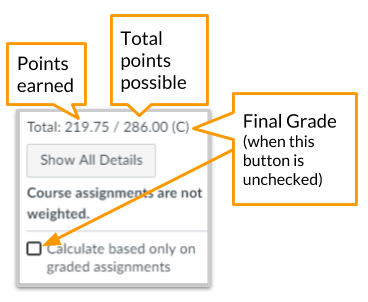
Late assignments

Each assignment must be submitted before the Due date and time as specified on the Syllabus Schedule or Modules list. The Available Until date and time constitutes a grace period, which can be used in an emergency, or if you are ill (it cannot be used for every assignment). Students who submit using the Available Until date will incur a score reduction of 5% per day late.
If you need an extension due to extenuating circumstances, please request it in writing via the Canvas Inbox before the Due date.
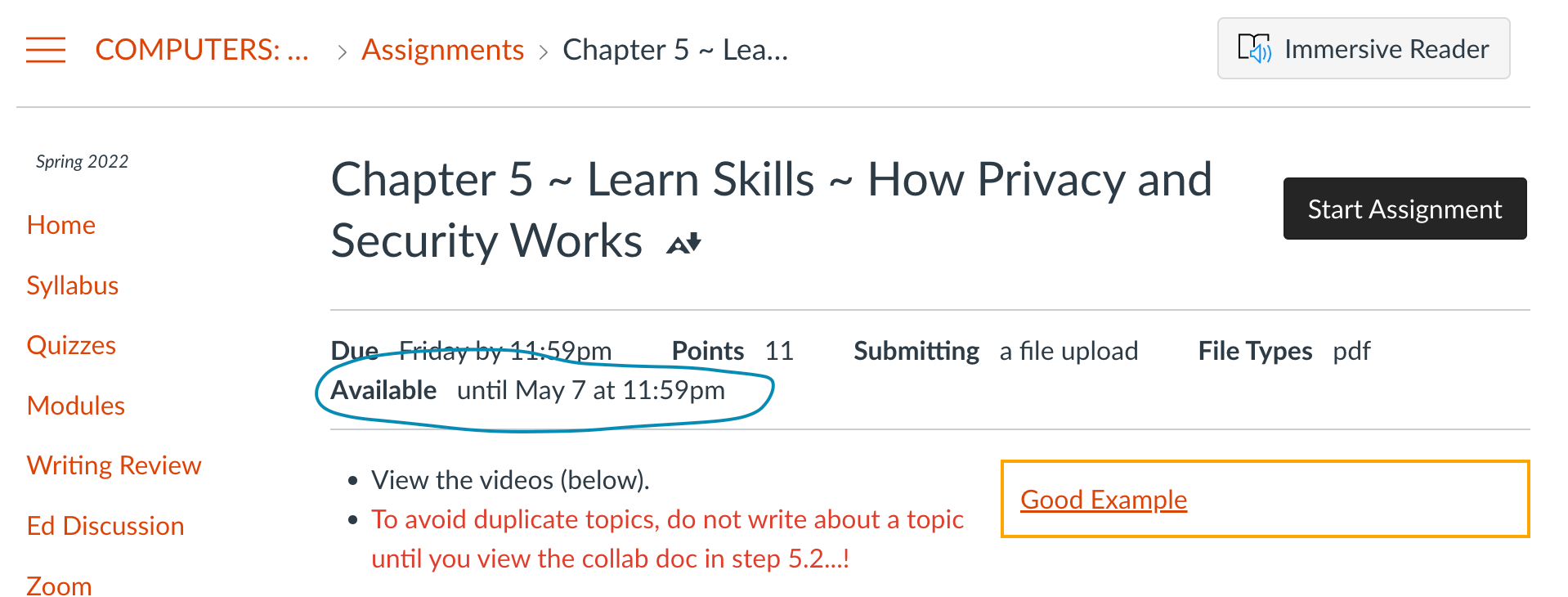
Notify your instructors right away when there is a personal crisis. Some of us will waive the late penalties when students check in before Due dates. When they come afterword, however, we are less sympathetic. Just like with any employment, you'll be expected to check in immediately when a personal crisis will require a deadline extension.
Incompletes
Incomplete (I) grades may be granted only in emergency cases (usually only for a death in the family, major illness or injury, or birth of your child), and if the student has turned in 80% of the points possible (in other words, usually everything but the final project). If you are having any difficulty that might prevent you from completing the coursework, please don’t wait until the end of the term to communicate with me; let me know right away.
Writing and Illustration Requirements
This course is not a writing-intensive course (WIC) but it does require writing instead of weekly quizzes and exams. The writing conventions required in this class include writing about research in the third-person style, bolding the names of key concepts, and hyperlinking the titles of articles/movies in sentences in paragraphs (rather than citing at the end). All writing must be checked using one of the software tools mentioned below in the Software section. View the Writing Samples to compare what meets requirements and what does not.
Bibliography entries will require the author, title, publisher, publish date, and URL. From chapter 2 on, bibliographies will be required in Skills assignments (but not Discussions).
Avoiding Plagiarism
This course (and many at OSU) will require you to submit written assignments to TurnItIn to check for plagiarism. Understanding the resulting Originality Report is critical to your success. You'll be expected to read it every week. Also, do you know the differences between plagiarizing, cheating, and infringing on copyrights? Even if you do, please read and understand those differences as they pertain to this course.
Scroll through the Avoiding Plagiarism diagram to learn how to keep from cheating and plagiarizing.
TurnItIn's Originality Highlighting.
When you submit work for this course, it will often be a PDF file, which gets simultaneously added to Canvas and TurnItIn. TurnItIn will check for plagiarism against other students' submissions from OSU and other colleges as well as online sources. After you fix plagiarism problems, you can resubmit a new PDF file before the Available Until date. Do not attempt to submit a second time after the Available Until; it will not be accepted. Check the report regardless of the percentage.
Scroll through the Checking Originality in TurnItIn guide to read about how the Originality Report works. The diagram at the bottom of the article will clarify what to look for and how to fix potential errors. Don't skip it!
Ecampus also provides more detail about Academic Misconduct.
Illustrations
Some projects require the use of illustrations or movies. Only add what is required and no more. Use illustrative, supportive, detailed media, such as movies, charts, graphs, maps, or infographics. Logos and simple memes or decorative images will not earn full credit.
Materials & Tools
Textbook
This course uses an online open textbook (free). Weekly objectives, detailed instructions, readings, viewings, help, and scoring criteria are provided in each chapter.
No printed textbook purchase is required.
Add each of these websites to separate TABS in your browser:

Internet Service
Learn more about internet service for different situations:
- Internet Service (OSU Help Documents)
- Affordable Connectivity Program The USA Federal government will provide students with free or reduced internet service. Participating states.
- How to Use Your Phone as a Hotspot. Great if the power goes out (but some phone battery life left).
- How to Set up Mesh WiFi Networks Easily
Hardware
On-campus students attending twice-weekly sessions will need to bring a laptop computer to class. Tablet computers may suffice for some in-class activities. Consult the OSU Library if you need to borrow a laptop.
Online students will need a laptop or desktop computer. Tablet computers may suffice for some in-class activities. Consult the OSU Library if you need to borrow a laptop.
Accounts and Software
The following accounts must be set up and running before class begins:
- Internet Service
- DUO 2-factor authentication access.
- Canvas.
Access Canvas using this URL: canvas.oregonstate.edu. (Requires DUO 2-factor authentication.) - OSU Valley Library (Requires DUO 2-factor authentication.)
- Zoom will be used for office hours during 2022/23. (Sign up at https://is.oregonstate.edu/zoom then access a Zoom session from inside Canvas courses.)
Free and Reduced Internet Service
The USA Federal government's Affordable Connectivity Program will provide students with free or reduced internet service. More about the broadband benefit.
Cloud Accounts
Cloud accounts will be used for backing up your work as well as completing some assignments. (Each requires ONID email and password and Duo):
- OSU G-Suite for Google Drive, Email, and applications
- OSU Sharepoint/OneDrive for Microsoft applications
- OSU Box drive for backing up all files.
Office Applications
Application requirements are based on your existing computer. Choose either of these combinations to complete Skills assignments:
- Windows with Microsoft Word, Excel, PowerPoint, and Google Drawings, or Google apps.
- Chromebook or Linux with Google Docs, Sheets, Slides, and Drawings.
- Apple Macintosh with Microsoft Office or Google applications. (Apple applications are not covered in this course.)
Use of online Microsoft Office applications is not recommended for some assignments due to missing menu options. Use the Editing menu to access the Open in Desktop App to download the app to your hard drive.
Grammar Checking Browser/Application Extension
Chrome browser for Mac, Windows, or Chromebook users, along with one of these browser extensions to improve grammar and spelling in all the applications you'll use this term:
- LanguageTool (preferred, because it is free and faster than Grammarly)
- Grammarly (many students already subscribe to this service)
Writing Requirements and Samples
When instructions ask you to summarize or synthesize an article(s) or movie(s), then write about it in the expository third-person style:
- Expository style explains who, what, when, where, how, and why in a factual, unbiased manner. It must be devoid of opinion or dramatic wording.
- Third-person style refers to what the author wrote about, rather than what you think about the content of the article. Pronouns are typically "she", "he", "they", but the more modern, inclusive way to refer to the author is with "they". Refrain from using second-person pronouns such as "you".
When instructions ask you for a personal opinion or about your process, then write in the first-person style, which allows you to refer to yourself.
Paragraphs must also include:
- Bold style applied to key concept names (not long phrases; not repeated generic words).
- Hyperlinked Titles of the source in a sentence in the paragraph.
- ...not the publisher or domain name.
- ...not a key word or phrase.
The following four writing samples correlate with rubrics for each chapter's required writing assignment. Scroll down...
The following sample paragraph meets writing requirements because it:
- Is written in the expository third-person style.
- Includes enough detail about who said what.
- Includes bolded key concepts.
- Includes a hyperlink in the title of the article/movie.
When asking questions of a search engine, it is able to list search results very quickly because it has already indexed most of the files online around the world, according to The Internet: How Search Works. Google, for example, sends a spider algorithm out to the Internet to crawl through the hyperlinked web pages so it can categorize and archive them for later. Hyperlinks from one web page to another help the spider find even more pages to index in the database of web pages. Web pages are then ranked by the page title, key words and phrases, and by how many other pages link to them, resulting in page rank. Marketing professionals try to out-smart the algorithms so their pages will list higher in search results. Google must constantly improve the algorithms using machine learning, whereby the algorithm understands cultural meanings and not just single words.
The following sample paragraph does not meet all requirements because it is missing a hyperlink in the title of the article/movie and the key concept names are missing bold style.
When asking questions of a search engine, it is able to list search results very quickly because it has already indexed most of the files online around the world, according to The Internet: How Search Works. Google, for example, sends a spider algorithm out to the Internet to crawl through the linked web pages so it can categorize and archive them for later. Hyperlinks from one web page to another help the spider find even more pages to index in the database of web pages. Web pages are then ranked by the page title, key words and phrases, and by how many other pages link to them, resulting in page rank. Marketing professionals try to out-smart the algorithms so their pages will list higher in search results. Google must constantly improve them using machine learning, whereby the algorithm understands cultural meanings and not just single words.
The following sample paragraph does not meet requirements because it is written in the first-person style, focuses too much on introducing the article rather than providing details about who did what how, as noted in the content of the article, it lacks bold applied to key concept names, and it lacks a hyperlink in the title of the article/movie.
In this paragraph I’ll be talking about things I literally knew nothing about. This paragraph focuses on the search engine article found in the textbook. It talks about some of the ways search engines work, which is about spiders crawling to pick up sites and list them.
The following sample paragraph is copied directly from an article by Google, which is plagiarism. Short quoted passages are allowed in expository writing, as long as the title of the original article is hyperlinked in the paragraph and most of the writing is the student's original writing.
Google Search puts the world's information at your fingertips, helping people find helpful results for billions of queries every day. From ranking systems to features that show up when you search, this series explains what makes Google useful and how we connect you to the information you're looking for.
Print a copy of the Writing Samples.
Prerequiste Skills
Basic computer knowledge is essential. Know each of the skills on this checklist to ensure you can start Chapter 1 with confidence. Use the Prerequisite Help Discussion in our Canvas course to learn about the ones you're missing.
Print the Prerequiste Skills Checklist as needed.
Statements of Expectations
Land Acknowledgement
Oregon State University in Corvallis, Oregon, is located within the traditional homelands of the Mary’s River or Ampinefu Band of Kalapuya. Following the Willamette Valley Treaty of 1855, Kalapuya people were forcibly removed to reservations in Western Oregon. Today, living descendants of these people are a part of the Confederated Tribes of Grand Ronde Community of Oregon (grandronde.org) and the Confederated Tribes of the Siletz Indians (ctsi.nsn.us).
Establishing a Positive Community
It is important you feel safe and welcome in this course. If somebody is making discriminatory comments against you, sexually harassing you, or excluding you in other ways, contact the instructor, your academic advisor, and/or report what happened at Student Conduct Reporting, so we can connect you with resources.
Remember that when you communicate online, you cannot provide eye contact and body language to help explain yourself, so your message may be misunderstood. Sometimes the thread of a message is lost, making readers rely on memory (which is often faulty). And if you need the reader to act on your request, good manners will help you be successful. Use the following to ensure you communicate professionally.
Emotional & Cultural Intelligence
The following is adapted from Dr. Susan Shaw, Oregon State University
- Make a personal commitment to learning about, understanding, and supporting your peers.
- Assume the best of others in the class and expect the best from them.
- Acknowledge the impact of sexism, racism, ethnocentrism, classism, heterosexism, ageism, and ableism on the lives of class members.
- Recognize and value the experiences, abilities, and knowledge each person brings to class. Value the diversity of the class.
- Participate actively in the discussions, having completed the readings and thought about the issues.
- Pay close attention to what your classmates write in their online comments. Ask clarifying questions, when appropriate. These questions are meant to probe and shed new light, not to minimize or devalue comments.
- Think through and re-read your comments before you post them.
- Never make derogatory comments toward another person in the class.
- Do not make sexist, racist, homophobic, or victim-blaming comments at all.
- Disagree with ideas, but do not make personal attacks.
- Be open to being challenged or confronted with your ideas or prejudices.
- Challenge others with the intent of facilitating growth. Do not demean or embarrass others.
- Encourage others to develop and share their ideas.
- Be willing to change.
Student Conduct: This manual provides the purpose, definitions, jurisdiction, responsibilities, prohibited conduct, process and procedures, sanctions, authorities, and appeals students must know in order to succeed at OSU.
Cyberbullying on the College Campus: Understand the different types of cyberbullying and how to avoid them.
Student Bill of Rights: OSU has twelve established student rights. They include due process in all university disciplinary processes, an equal opportunity to learn, and grading in accordance with the course syllabus.
Religious Accommodation Process: Oregon State University is required to provide reasonable accommodations for employee and student sincerely-held religious beliefs. It is incumbent on the student making the request to make the faculty member aware of the request as soon as possible prior to the need for the accommodation. See the policy.
Services
Students with Disabilities: Accommodations for students with disabilities are determined and approved by Disability Access Services (DAS). If you, as a student, believe you are eligible for accommodations but have not obtained approval please contact DAS immediately at 541-737-4098 or at http://ds.oregonstate.edu. DAS notifies students and faculty members of approved academic accommodations and coordinates implementation of those accommodations. While not required, students and faculty members are encouraged to discuss details of the implementation of individual accommodations.
Reach Out for Success (on-campus students): University students encounter setbacks from time to time. If you encounter difficulties and need assistance, it’s important to reach out. Consider discussing the situation with an instructor or academic advisor. Learn about resources that assist with wellness and academic success at oregonstate.edu/ReachOut. If you are in immediate crisis, please contact the Crisis Text Line by texting OREGON to 741-741 or call the National Suicide Prevention Lifeline at 1-800-273-TALK (8255).
Reach Out for Success (online students): University students encounter setbacks from time to time. If you encounter difficulties and need assistance, it’s important to reach out. Consider discussing the situation with an instructor or academic advisor. Learn about resources that assist with wellness and academic success. Ecampus students are always encouraged to discuss issues that impact your academic success with the Ecampus Success Team. Email ecampus.success@oregonstate.edu to identify strategies and resources that can support you in your educational goals.
- For Mental Health: Learn about counseling and psychological resources for Ecampus students. If you are in immediate crisis, please contact the Crisis Text Line by texting OREGON to 741-741 or call the National Suicide Prevention Lifeline at 1-800-273-TALK (8255).
- Financial Hardship Statement: Any student whose academic performance is impacted due to financial stress or the inability to afford groceries, housing, and other necessities for any reason is urged to contact the Director of Care for support (541-737-8748).
Tutoring and Writing Assistance:
- Online students will use TutorMe, accessed from Canvas, when they need writing assistance. TutorMe is a leading provider of online tutoring and learner support services fully staffed by experienced, trained and monitored tutors.
- On-campus students can utilize the OSU Writing Center when they need writing assistance.
OSU Service Desk and Accounts: Get help and learn more about your OSU technologies. If you experience any errors or problems while in your online course, contact 24-7 Canvas Support through the Help link within Canvas. If you experience computer difficulties, need help downloading a browser or plug-in, or need assistance logging into a course, contact the IS Service Desk for assistance. You can call (541) 737-8787 or visit the IS Service Desk online.
Academic Calendar: All students are subject to the registration and refund deadlines as stated in the Academic Calendar
Student Learning Experiences Survey: During Fall, Winter, and Spring term the online Student Learning Experience surveys open to students the Wednesday of week 9 and close the Sunday before Finals Week. Students will receive notification, instructions, and the link through their ONID email. They may also log into the survey via MyOregonState or directly. Survey results are extremely important and are used to help improve courses and the learning experience of future students. Responses are anonymous (unless a student chooses to “sign” their comments, agreeing to relinquish anonymity of written comments) and are not available to instructors until after grades have been posted. The results of scaled questions and signed comments go to both the instructor and their unit head/supervisor. Anonymous (unsigned) comments go to the instructor only.
Take the Syllabus Quiz
By taking the quiz about this syllabus, it lets the instructor know that you are ready to tackle the complex assignments and discussions. Click on the first Home > Assignment link in the Canvas course.